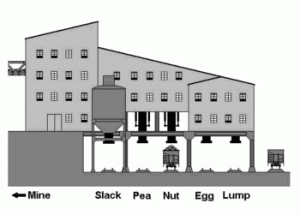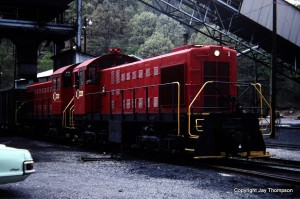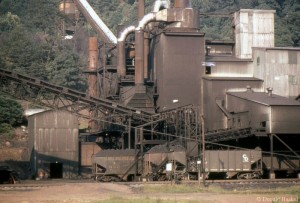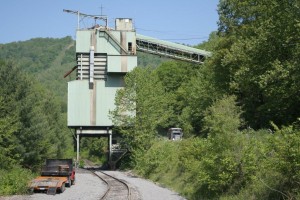by Dan Bourque
 In ABCs of Coal, we learned a little about how coal is formed, now we’re going to look at coal where it meets the rails–at the tipple. I’m not going to go into depth about mining techniques, but here’s the basics. Coal is usually mined in two ways. The first is the traditional mine using a series of shafts and elevators to bring the excavated coal to the surface. The second is the strip mine where the ground on top of the coal is removed to expose the coal. Bulldozers, big buckets, and dump trucks then handle the coal and move it to where it needs to go. Many times, in a strip mine, the dump truck is the primary means of moving coal to the rails. In other strip mine operations, long conveyors bring the coal over hills and valleys to the loader. Let’s talk about the most traditional coal loader: the tipple.
In ABCs of Coal, we learned a little about how coal is formed, now we’re going to look at coal where it meets the rails–at the tipple. I’m not going to go into depth about mining techniques, but here’s the basics. Coal is usually mined in two ways. The first is the traditional mine using a series of shafts and elevators to bring the excavated coal to the surface. The second is the strip mine where the ground on top of the coal is removed to expose the coal. Bulldozers, big buckets, and dump trucks then handle the coal and move it to where it needs to go. Many times, in a strip mine, the dump truck is the primary means of moving coal to the rails. In other strip mine operations, long conveyors bring the coal over hills and valleys to the loader. Let’s talk about the most traditional coal loader: the tipple.
Tipples
The traditional tipple is usually situated near the mine, but it can be served by trucks or conveyors as well. In operation, the coal, in raw form, is brought into the tipple where it is cleaned and sorted. In the tipple, coal runs over various size screens starting with small openings and working down to the largest openings. The different sizes are typically stored separately and loaded over different tracks. The smallest is loaded on the track nearest the “top” of the tipple and each successive track loads larger and larger chunks of coal. In addition to sizing the coal, tipples would often wash the coal and treat it with oil to decrease the dustiness. In many cases, slack coal was stored in a silo rather than a bin to reduce the risks of flash fires.
Truck Dumps
The second type of coal loader is the truck dump. A truck dump is used when a mine is located some distance away from the rails. The simplest form of truck dump is a ramp which allows the truck to simply back-up onto a pier and empty its load into the waiting coal hopper (now outlawed due to a high number of accidents involving the truck or front-end loader falling into the hopper). Other truck dumps use bulldozers to load coal that has been dumped on the ground into a conveyor angled over the hopper car. More modern truck dumps have small crushers which make the coal more uniform and use conveyor-fed chutes for more efficient loading. Truck dumps typically load from 1 to 30 cars per day over one or two tracks. Truck dumps are most prevalent in Eastern Kentucky and Western Virginia and make up the majority of loading points in modern-day Appalachia.
Flood Loaders
The third type of coal loading operation is the more modern flood loader. A flood loader can load an entire train in a relatively short amount of time. Typically, a train is run underneath the loader very slowly while the coal is emptied via a specialized chute. Flood loaders are very popular as loading sources for unit trains and currently load the lion’s share of coal with huge operations capable of loading hundred car trains every day. Today’s flood loaders are also typically located closer to the mainline than their tipple cousins and are often served by miles of conveyors.
Transloaders

Two ALCo S2s back-to-back work the loader at the Appalachia, Virginia Westmoreland Coal Transloader. These two units actually carry GE builder plates after being rebuilt and re-engined by GE after Westmoreland Coal bought the previous coal company out -Dan Bourque collection
A unique form of coal loader is the transloader. In a transloader operation, coal is brought in from several mines via train. The transloader facility then blends the coal to create the best product for its customer. This coal is typically stored in huge concrete silos awaiting shipment. When a customer needs coal, the transloader typically uses a flood loader at the facility to load a unit train.
One thing is for sure, no two coal loaders are exactly alike! Loaders can be a mix of tipple and truck dump, transloader and flood loader, loaders may even get coal from both conveyors and an on-site mine. These descriptions are merely intended to simplify things a bit.
Coal Loader Evolution in a Nutshell
From the turn of the century into the 1950s, tipples dominated the loading scene. Sized coal was very common, and single car loadings were the norm. The typical coal hopper was a 50-55 ton twin car. In the ’50s, 70 ton triple and quad hoppers were quickly becoming the standard. As mines near the tipples dried-up, truck dumps began to increase in popularity. With a truck dump, you could mine several different seams of coal without having to move your loader. In the mid ’60s, coal hoppers were growing from 50 and 70 tons to 100 tons or more. As hoppers grew, so did loading facilities. Flood loaders began replacing dozens of tipples as strip mining became more popular. Huge conveyors, some miles long, brought coal in from across the ridges to these giants. Other operations used older hoppers as shuttle cars to ferry coal from smaller tipples and truck dumps to transloading facilities which mixed the coal and loaded from flood loaders. In the ’70s, during the energy crisis, the coal boom saw a big increase in the use of unit trains. Unit trains load the entire train at one point and deliver it to a single receiver–usually a power plant. Many new truck dumps were also constructed to handle the increase in traffic due to the energy crisis. By the 1980s, nearly all of the tipples were gone. 50 ton hoppers were rare, and even 70 ton hoppers were being rapidly retired. Today, the truck dumps are still around; but one-by-one, they are slowly shutting down as the need for single car loadings diminishes and the demand for western coal increases.
In the next article, ABCs of Coal Loads, we’ll talk about how the different types of loaders affect the appearance of the coal load. For more pictures of coal loaders, see the coal loader photo page.
Related Products:







Pingback: ABCs of Coal – Appalachian Railroad Modeling